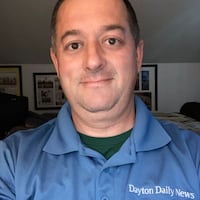“We’re in the heartland of America: Springfield, Ohio,” Summerall said. “This is the stadium: Wittenberg Stadium, the home of the Tigers. It seats 7,000, and today it’s just about packed. Good afternoon, and well, we know it’s Division III football. They’re not as big as the players in the NFL, for sure. They’re probably not as talented as they are in the NFL, but they still play with the same amount of intensity, and they still like the game just as much as whatever they play at whatever level. Believe me, after 31 years of every Sunday being associated with the NFL either as a player or broadcaster, it’s nice to be on campus.”
The NFL was in the midst of a 57-day strike that season when CBS sent crews to four Division III games. Its contract with the NCAA called for it to broadcast four D-III games each year, and with NFL reruns during the strike earning low ratings, it lived up to the contract with one day of live football games.
Summerall and John Madden, who had yet to gain added fame for putting his name on a video game, got the game in Springfield between the Tigers and their big rival at the time in the Ohio Athletic Conference, Baldwin-Wallace. Eight months earlier, Summerall and Madden announced Super Bowl XVI between the Bengals and 49ers in Detroit.
Pat O’Brien, better known these days for having hosted entertainment shows like Access Hollywood and The Insider, was the sideline reporter.
Wittenberg had to move the game from Saturday to Sunday, which it initially was hesitant to do, but it was a small price to pay. The game was shown coast-to-coast, except in nine southern states where another Division III game, West Georgia at Millsaps, aired.
“The intensity at practice all week for the Baldwin-Wallace game was always at the highest level,” said Jeff Nichols, a 1979 North graduate who played defensive back for the Tigers. “But the added attraction of CBS being there made it even more intense. We enjoyed John and Pat coming out to practice. I remember them sitting down against the fence, watching us practice and talking to the players and getting a feel for who’s who and what’s what, so they would be prepared for the game on Sunday.”
The broadcasting team arrived three to four days in advance of the game. Madden, who famously avoided airplanes then and now, took a train from New York City to Toledo and drove to Springfield.
“I’m excited about it,” he said that week. “I volunteered for this when I first heard about it. I really did. Last week we ran replay of the Super Bowl and sat in the studio and talked about the strike. Shoot, that’s boring.”
Brian Timm, a student manager for the Tigers in 1982, remembers watching film with Madden and Summerall.
“John Madden was running the projector,” he said. “He sat with the coaches and moved the plays back and forth, asking about certain players. I remember clear as day Pat Summerall sitting in the back of the room smoking cigarettes and not paying much attention. John was very active in that session.”
Maurer kept the Tigers focused on the game throughout the week. But it was hard to ignore the crowd that Saturday.
“There wasn’t anything else going on that day,” said Wittenberg running back Dana Williams, who now lives in Dublin, Ohio. “That’s why CBS put it on. A lot of people came out to try to get on TV.”
Just before kickoff, Maurer did a pregame interview with O’Brien on the field.
About the Author
